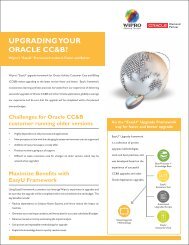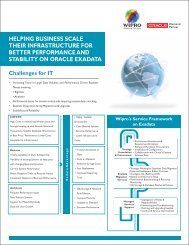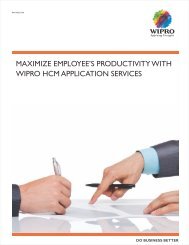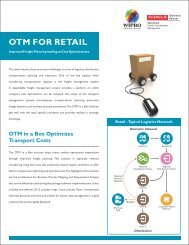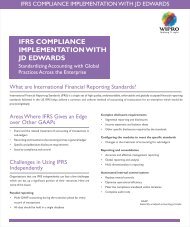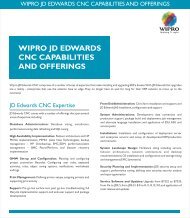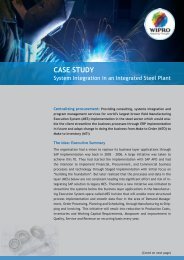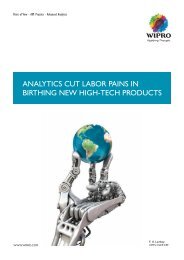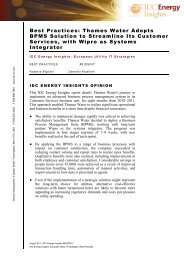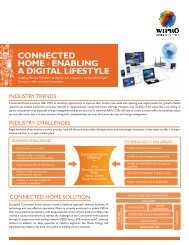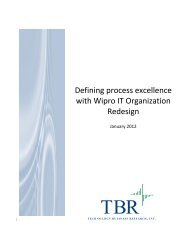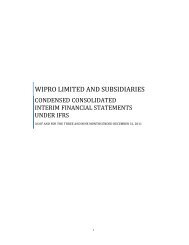Painting the CPG Supply Chain GREEN
Painting the CPG Supply Chain GREEN
Painting the CPG Supply Chain GREEN
You also want an ePaper? Increase the reach of your titles
YUMPU automatically turns print PDFs into web optimized ePapers that Google loves.
<strong>Painting</strong> <strong>the</strong> <strong>CPG</strong> <strong>Supply</strong><br />
<strong>Chain</strong> <strong>GREEN</strong><br />
April, 2009<br />
Subramanian Bala and K Suraj<br />
Environmental sustainability in <strong>the</strong> 21st century continues to rage as a topic of major<br />
interest. For businesses, sustainability has become an issue of corporate image and<br />
responsibility towards <strong>the</strong> society from which <strong>the</strong>y generate revenues. However,<br />
maintaining a balance between profitability and sustainability has been a difficult line<br />
for businesses to toe. This paper is an attempt to arrive at solutions which will aid<br />
organizations to realize sustainability ambitions efficiently. The ability of packaged<br />
implementations to extend <strong>the</strong>ir influence across <strong>the</strong> supply chain is a factor to be<br />
capitalized on to achieve significant headway in improving an organization’s carbon<br />
footprint.<br />
Confidential © Copyright 2009 Wipro Ltd 1
Contents<br />
Introduction.............................................................................................3<br />
Where should <strong>CPG</strong> firms turn <strong>the</strong>ir attention to?..............................5<br />
Packaged Implementations- Key to Green..........................................9<br />
Green Configurations/Business Rules.........................................................9<br />
Sourcing .................................................................................................................9<br />
Manufacturing/Production..................................................................................10<br />
Distribution............................................................................................................12<br />
Confidential © Copyright 2009 Wipro Ltd<br />
2
Introduction<br />
Environment and it’s sustainability in <strong>the</strong> future has been a topic of intense debate in <strong>the</strong> last decade.<br />
The Ozone Hole and global warming are topics which have garnered immense attention. The<br />
estimated economic damage stands at about US $85 1 for each ton of carbon dioxide emission.<br />
Organizations have added sustainability in <strong>the</strong>ir corporate strategies. Although <strong>the</strong> current economic<br />
slowdown has applied breaks on some of <strong>the</strong> major initiatives companies had embarked upon,<br />
environmental sustainability will be an inevitable part of company strategy in <strong>the</strong> future.<br />
Figure 1 gives us a glimpse of impact <strong>the</strong> Consumer Packaged Goods (<strong>CPG</strong>) companies have had on<br />
<strong>the</strong> environment.<br />
Figure 1: Waste Creation in Industries 2 Figure 2: Ecological footprint per US$ 1 million spent by consumers 3<br />
Waste disposal forms just one component of <strong>the</strong> sustainability issue; o<strong>the</strong>rs being green house gas<br />
emissions and usage of toxic materials in production. With <strong>the</strong> largest environmental footprint, use of<br />
more natural resources than o<strong>the</strong>r industries, and use of chemicals and energy, <strong>the</strong> <strong>CPG</strong> industry had<br />
to play a major role in curbing its impact on <strong>the</strong> environment.<br />
Figure 2 displays <strong>the</strong> impact each of <strong>the</strong> listed industries have on <strong>the</strong> environment. The listed<br />
industries are from a household point of view and <strong>the</strong> portfolio of spends <strong>the</strong>ir budget entails.<br />
Some <strong>CPG</strong> industry majors have come up with innovative initiatives to curb <strong>the</strong>ir negative impact on<br />
<strong>the</strong> environment. Increasing consumer knowledge and a consequent discretion in consumer behavior<br />
puts <strong>CPG</strong> majors in a tight position being an industry closest to consumers and <strong>the</strong>ir needs. A few<br />
efforts in this direction brook our attention:<br />
Apparel and Footwear major Nike spends about $800 mn on its waste management efforts every<br />
year. Nike maintains <strong>the</strong> green indices of its products. Each Nike shoe comes with a green index<br />
indicating <strong>the</strong> level of impact on <strong>the</strong> environment 4.<br />
Food and Beverages Company Nestle has embarked on ambitious efforts to maximize recycling<br />
plastic and reduce plastic content in <strong>the</strong> bottles from 12.4 grams/bottle to 9.8 grams which are<br />
used by Nestle Waters 5.<br />
Confidential © Copyright 2009 Wipro Ltd<br />
3
Home and Personal Care leader Procter and Gamble Co. reduced its water and energy<br />
consumption by 6% to 8% bringing <strong>the</strong> total reduction since 2002 to about 20% 5. By 2012,<br />
P&G plans to sell $20 bn worth sustainable products. The company sold $2.05 bn worth<br />
sustainable products which includes 6:<br />
- Concentrated liquid laundry detergent<br />
- Concentrated powdered detergent in Europe<br />
- Crest Whitestrips (Uses lesser material)<br />
Confidential © Copyright 2009 Wipro Ltd<br />
4
Where should <strong>CPG</strong> firms turn <strong>the</strong>ir attention to?<br />
Figure 3: <strong>CPG</strong> value chain and environmental impact<br />
While manufacturing may be able to come up with significant savings in energy consumption, logistics<br />
and transportation more than make up for that due to <strong>the</strong>ir fuel consumption. Similarly o<strong>the</strong>r functions<br />
across <strong>the</strong> supply chain pursue activities in silos which negate <strong>the</strong> significant results achieved from one<br />
stage of <strong>the</strong> supply chain. Green efforts often provide cost efficiency, continuous improvement and<br />
profitability 7 which is ano<strong>the</strong>r reason for companies to pursue Green Initiatives. What has been<br />
observed is that while individual efforts by <strong>the</strong> manufacturer/brand owner may result in significant<br />
reduction in carbon footprint, but achieving same success in <strong>the</strong> extended supply chain is still a major<br />
challenge.<br />
The first step in arriving at solution addressing <strong>the</strong>se challenges will be to determine <strong>the</strong> impact of each<br />
stage in <strong>the</strong> supply chain on environment and sustainability where <strong>the</strong> <strong>CPG</strong> manufacturer has control<br />
over. The following chart summarizes <strong>the</strong> modes of impact on environment and <strong>the</strong> how do each stage<br />
of supply chain contribute to this.<br />
Confidential © Copyright 2009 Wipro Ltd<br />
5
Consumer Packaged goods <strong>Supply</strong> <strong>Chain</strong><br />
Sourcing<br />
Mfg<br />
Mode of<br />
Impact<br />
Improper disposal<br />
of waste created<br />
during production<br />
and transportation<br />
from suppliers<br />
Improper Disposal<br />
of waste created<br />
during Production<br />
and Management<br />
of product returns<br />
Waste creation due<br />
to Inefficiency of<br />
operations<br />
Waste Greenhouse gas (GHG) Non Renewable resource usage<br />
Toxic materials<br />
Instances of Modes of Instances of<br />
Modes of Instances of<br />
Impact Impact Impact Modes of Impact Instances of Impact Impact Impact<br />
Plastic packaging<br />
materials used for<br />
transporting apparel Sourcing from<br />
from Asian countries. suppliers distributed<br />
Non Bio degradability of across geographies<br />
Plastic is a major<br />
challenge<br />
Environmentally<br />
unsustainable<br />
Supplier production<br />
processes<br />
Plastic water bottles<br />
take upto 1000 years to<br />
decompose in Landfills. The emissions from<br />
The recycle rate of production facilities<br />
Plastic bottles in US is<br />
only 14%<br />
Usage of additional PET<br />
material in cola bottle<br />
production.<br />
Proliferation of SKUs<br />
and accompanying<br />
impacts on design,<br />
production and<br />
packaging<br />
Causes of Adverse Impact On Environment<br />
Apparel Companies rely<br />
on suppliers from Asia for<br />
<strong>the</strong>ir products. Food and<br />
agriculture based<br />
companies have to rely<br />
on agri intensive areas for<br />
sourcing inputs. The<br />
emissions increase with<br />
<strong>the</strong> distance of <strong>the</strong><br />
supplier<br />
Cotton used extensively<br />
in Apparel industry is<br />
extremely dependent on<br />
Water and Pesticides<br />
Inefficient<br />
transportation<br />
methods<br />
Emissions from Meat Use of petroleum<br />
industry accounts for 18%<br />
based fuels for<br />
of total green house gas<br />
emissions<br />
energy generation<br />
<strong>CPG</strong> companies with 50<br />
or 100 different SKUs pay<br />
more for packaging<br />
Inefficient Production<br />
because suppliers are<br />
forced to perform shorter<br />
processes<br />
production runs of<br />
myriad package types<br />
Sub optimal usage of trucks,<br />
air/land transportation leading<br />
to multiple trips which increases<br />
fuel usage, Shrinkage losses<br />
during transportation and<br />
storage. The energy source is<br />
petroleum based and<br />
inefficiency in processes leads<br />
to excessive fuel usage and GHG<br />
emissions<br />
Renewable sources of energy<br />
(Ethanol, water, solar and wind)<br />
account for about 6% of energy<br />
sources.<br />
18% of US corn production is<br />
sourced for Ethanol production<br />
accounting for 1% of energy<br />
source<br />
The chemicals<br />
and o<strong>the</strong>r<br />
materials which<br />
are used for<br />
Production<br />
Production<br />
processes<br />
Confidential © Copyright 2009 Wipro Ltd 6<br />
Pesticides and chemicals used<br />
in grain production, <strong>the</strong> blue<br />
dust during Jeans production is<br />
heavy lungs irritant<br />
Use of PET bottles in beverages<br />
industry, Use of heavy metals<br />
and carcinogenic dyes in<br />
apparel production, Use of<br />
Lead based materials in<br />
cosmetics like Lipsticks
Distribution<br />
Mode of<br />
Impact<br />
Waste disposal<br />
Waste creation due<br />
to Inefficiency of<br />
operations<br />
Instances of<br />
Impact<br />
Packaging waste makes<br />
up 30 percent of <strong>the</strong><br />
solid waste in <strong>the</strong> U.S.<br />
Table 1: Modes of Impact Vs. <strong>Supply</strong> <strong>Chain</strong> Stages<br />
Confidential © Copyright 2009 Wipro Ltd<br />
Modes of<br />
Impact<br />
Inefficiency in<br />
Distribution of goods<br />
to customers at<br />
diverse locations<br />
The pallets and<br />
cardboard boxes used in<br />
<strong>CPG</strong> warehouses are<br />
discarded after minor<br />
breakage/defects. Usage<br />
of reusable packaging<br />
made of durable<br />
materials can result in<br />
$2 million savings per Inefficient Transport<br />
company<br />
processes<br />
Causes of Adverse Impact On Environment<br />
Waste Greenhouse gas (GHG)<br />
Non Renewable resource usage Toxic materials<br />
Instances of<br />
Impact Modes of Impact<br />
Networking and routing<br />
techniques which are<br />
based on insufficient<br />
collaboration among<br />
<strong>Supply</strong> <strong>Chain</strong> partners<br />
results in greater energy<br />
usage than optimal<br />
requirements. Use of<br />
Energy for Warehouse<br />
heavier packages results<br />
and distribution<br />
in increase in truckloads<br />
resulting greater fuel centers, transportation<br />
usage and GHG emissions of finished goods<br />
Sub optimal usage of<br />
trucks, air/land<br />
transportation leading to<br />
multiple trips for demand<br />
replenishment<br />
7<br />
Instances of<br />
Impact<br />
Lighting consumes 50-60%<br />
of energy while <strong>the</strong> rest is<br />
distributed among electric<br />
vehicles, hot water services,<br />
general power and air<br />
conditioning facilities<br />
Modes of<br />
Impact Instances of Impact
The above table paints <strong>the</strong> picture of impact of three stages of supply chain. An example to illustrate<br />
<strong>the</strong> distribution of impact from supply chain stages is in <strong>the</strong> soft drink manufacturing 8. The<br />
distribution of emissions across <strong>the</strong> supply chain is<br />
• Sourcing/raw materials : 15-20%<br />
• Manufacturing: 20-25%<br />
• Distribution: 10-15%<br />
This sums up to about 50% - 60% of emissions in <strong>the</strong> supply chain. O<strong>the</strong>r factors like toxic material<br />
usage, waste management, and use of non renewable sources of energy fur<strong>the</strong>r add to <strong>the</strong> total<br />
environmental impact of <strong>the</strong> <strong>CPG</strong> supply chain.<br />
The authors believe that technology can play a role in enhancing adoption and implementation of<br />
Green Initiatives. In <strong>the</strong> context of <strong>CPG</strong> Industry, Enterprise Resource Planning (ERP) systems are<br />
prevalent and in <strong>the</strong> following sections, we look at <strong>the</strong> possibility of configuring business rules for a<br />
Green <strong>Supply</strong> <strong>Chain</strong> in ERP.<br />
Confidential © Copyright 2009 Wipro Ltd 8
Packaged Implementations - Key to Green<br />
ERP and o<strong>the</strong>r packaged implementations used in <strong>the</strong> <strong>CPG</strong> industry cover <strong>the</strong> length of a <strong>CPG</strong><br />
company’s supply chain right from sourcing <strong>the</strong> raw materials to manufacturing/production of<br />
finished goods to distribution. These packages can contribute immensely in achieving significant<br />
sustainability goals due to <strong>the</strong>ir reach across <strong>the</strong> supply chain.<br />
Green Configurations/Business Rules<br />
Packaged Implementations are customized to <strong>the</strong> business needs through industry/company specific<br />
rules which are configured in <strong>the</strong> packages.<br />
Green configurations would be business rules that can be configured during a package<br />
implementation. These rules will act as constraints while arriving at decisions during interactions<br />
with supply chain partners, like supplier decisions, work centre scheduling, distribution network<br />
decisions et al.<br />
Sourcing<br />
Supplier Decisions - Based on <strong>the</strong> detailed listing of <strong>the</strong> modes of environmental impact across<br />
various stages of <strong>the</strong> supply chain, a set of parameters are suggested here which would drive <strong>the</strong> green<br />
configurations while making sourcing decisions.<br />
Sourcing<br />
Waste<br />
Management<br />
Emissions<br />
Energy Usage<br />
Hazardous<br />
Materials<br />
Table 2: Green configuration metrics for sourcing<br />
Confidential © Copyright 2009 Wipro Ltd<br />
Waste created (supplier wise) (Tonnes)<br />
% of Non Bio degradable waste<br />
% of Waste recycled<br />
%Reduction in plastics achieved YoY<br />
%Reduction in packaging material achieved YoY<br />
Emissions from transportation (multi modal) (Metric Tonnes)<br />
% Reduction in no. of truck loads YoY<br />
Proximity of sourcing locations (Global/local suppliers)<br />
% of Suppliers using efficient routing algorithms in transportation<br />
Annual Energy Usage in storage, production (Kwh)<br />
% Reduction in energy usage<br />
% of Energy generated from Renewable energy sources<br />
% Levels of Toxic materials used<br />
Toxicity levels of ingredients used<br />
9
The green configuration configured in <strong>the</strong> sourcing module can be used to evaluate <strong>the</strong> production<br />
processes used by <strong>the</strong> supplier, supplier’s geographical locations and hence <strong>the</strong> transportation modes,<br />
<strong>the</strong> chemicals used in production. These factors will be used to arrive at a Green Rating for <strong>the</strong><br />
supplier. This in turn would be evaluated against <strong>the</strong> contracts with <strong>the</strong> supplier and <strong>the</strong> price lists to<br />
arrive at <strong>the</strong> most sustainable supplier.<br />
Manufacturing/Production<br />
The parameters which would aid in manufacturing decisions are:<br />
Manufacturing<br />
Waste<br />
Management<br />
Emissions<br />
Energy Usage<br />
Hazardous<br />
Materials<br />
Confidential © Copyright 2009 Wipro Ltd<br />
Annual waste created (Tonnes)<br />
% of Non Bio degradable waste<br />
% of Waste recycled<br />
%Reduction in plastics achieved YoY<br />
%Reduction in packaging material achieved YoY<br />
Total Emissions from production facilities (Metric tonnes)<br />
% of Production equipment meeting Sustainability standards<br />
Emissions distribution based on Product/brand/SKU (tonnes/unit)<br />
% Reduction achieved in number of SKUs<br />
Annual energy usage in storage, production (KwH)<br />
% of Renewable energy sources<br />
Machine uptime statistics (total hours)<br />
Rejection/defect rates at machines<br />
% of Organic products<br />
Table 3: Green configuration metrics for manufacturing<br />
Annual water consumption (cubic meters)<br />
The aforementioned parameters would fit in <strong>the</strong> green configurations and will have a twofold impact<br />
on improving <strong>the</strong> footprint of manufacturing in supply chain. This would be at:<br />
a) Operational level which would include <strong>the</strong> machine maintenance levels and energy usage<br />
statistics. The Green Configuration can be used to configure business rules in <strong>the</strong> packages<br />
governing <strong>the</strong> manufacturing modules. This would determine <strong>the</strong> energy usage statistics and <strong>the</strong><br />
share of sustainable energy sources in <strong>the</strong> same. These combined with <strong>the</strong> maintenance schedule of<br />
<strong>the</strong> machines and <strong>the</strong> usage history can be used to arrive at <strong>the</strong> Green Ratings for machines which<br />
in turn will translate to stakeholders like supervisors, sustainability managers to improve <strong>the</strong><br />
Green Ratings. The business rules configured in <strong>the</strong> package can hence, help in determining <strong>the</strong><br />
10
most efficient machine and <strong>the</strong> levels to which renewable energy sources can be used to operate<br />
<strong>the</strong> machine.<br />
b) Manufacturing This would include <strong>the</strong> parameters like <strong>the</strong> usage of toxic/non biodegradable<br />
materials in <strong>the</strong> production of finished products. Taking <strong>the</strong> example of PET bottles for soft drink<br />
packaging, Manufacturing Execution systems can play a major role in regulating <strong>the</strong> PET content<br />
in <strong>the</strong> bottles. Green Configurations added with MES can play a significant role in decreasing <strong>the</strong><br />
toxicity of <strong>the</strong> <strong>CPG</strong> products.<br />
An important source of waste creation is due to <strong>the</strong> demand supply gap. Lack of accuracy in<br />
replenishment of goods and resulting inventory buildups result in loss of products. A solution<br />
which is gaining acceptance in this respect is improving <strong>the</strong> demand visibility across <strong>the</strong><br />
supply chain. Having better tabs on <strong>the</strong> demand at customer’s end will help in coming with<br />
accurate Manufacturing schedules and better material and inventory management practices.<br />
Demand planning solution for fresh foods industry (iSDPS) is a composite solution developed<br />
by Wipro Technologies that aims to provide a consistent and simplified solution for managing<br />
<strong>the</strong> short-term production planning process in fresh food companies. Wipro Technologies<br />
worked closely with SAP AG as a member of <strong>the</strong> Industry Value Network group for consumer<br />
products to develop this solution. The solution recently helped <strong>the</strong> second most valuable<br />
consumer grocery brand in <strong>the</strong> U.K. in addressing need for an effective sub-daily production<br />
planning and scheduling system. The solution is geared towards cutting down waste created<br />
in <strong>the</strong> manufacturing process and help achieve significant savings through reduction in<br />
transportation costs.<br />
With its proven end to end service capabilities, Wipro can provide its clients with solutions to<br />
achieve significant results on green initiatives. Wipro was recently rated among top 5 global<br />
green brands in <strong>the</strong> world by Greenpeace.<br />
Confidential © Copyright 2009 Wipro Ltd<br />
11
Distribution<br />
The set of Green configuration parameters for distribution strategy would be<br />
Distribution<br />
Waste<br />
Management<br />
Confidential © Copyright 2009 Wipro Ltd<br />
Annual waste created (Tonnes)<br />
% of non bio degradable waste<br />
%Reduction in plastics achieved YoY<br />
Quantity of Packaging material used (Tonnes)<br />
%Reduction in packaging material achieved YoY<br />
Emissions Emissions from transportation (multi modal) (Metric tonnes)<br />
Energy Usage<br />
Table 4: Green configuration metrics for distribution<br />
Total energy usage in warehousing, loading/unloading (KWh)<br />
% Energy generated using renewable energy sources<br />
On <strong>the</strong> distribution side, <strong>the</strong> purpose of Green Configurations would be to arrive at Green Ratings by<br />
<strong>the</strong> amount of waste created in packaging and distribution, <strong>the</strong> inventory wastage statistics, and <strong>the</strong><br />
energy usage history. This can be combined with <strong>the</strong> shipment contracts and distributor centre location<br />
data to arrive at <strong>the</strong> appropriate distribution strategy.<br />
In this context, in addition to <strong>the</strong> mode of transportation and <strong>the</strong> routing decisions, distribution<br />
strategy can also be configured during <strong>the</strong> package implementation. One example could be <strong>the</strong> use of<br />
direct store delivery (DSD). Instead of <strong>the</strong> conventional 4 step supply chain where<br />
wholesalers/distributors play a major role, DSD could offer significant results in greening <strong>the</strong> supply<br />
chain. Green Configurations can determine <strong>the</strong> distribution strategy among <strong>the</strong> various options<br />
available and arrive at appropriate sustainable action plan.<br />
Advantages of Green Configurations<br />
Green configurations can help organizations in:<br />
• Achieve significant results in shorter timeframes: <strong>CPG</strong> firms are increasingly adopting packaged<br />
implementations to improve <strong>the</strong>ir efficiency in operations and rationalize <strong>the</strong>ir cost structure.<br />
Green configuration as business rules would add on to <strong>the</strong>se implementations and hence, would<br />
have a say on <strong>the</strong> company’s activities across supply chain resulting in significant results in<br />
improving <strong>the</strong>ir carbon footprint.<br />
12
• Cost efficiencies: As <strong>the</strong><br />
configurations add on to <strong>the</strong><br />
existing or ongoing<br />
implementation process,<br />
technology costs would be<br />
minimal.<br />
The solution suggested in this<br />
whitepaper can form a foundation<br />
for a greater and all encompassing<br />
initiative to leverage <strong>the</strong> complete IT<br />
organization across <strong>the</strong> supply chain<br />
to achieve sustainability goals. This<br />
could be in terms of how energy and<br />
resources can be routed and shared<br />
across business partners of <strong>the</strong><br />
supply chain, how business partners<br />
can utilize waste created in different<br />
stages and how products developed<br />
are more ecologically viable.<br />
Green initiatives are perceived to<br />
consume huge amounts of resources<br />
with much lesser benefits to<br />
business. While, this view is<br />
disputed often, <strong>the</strong> bottom-line is<br />
that approach towards<br />
implementation of green initiatives<br />
will make a huge difference. A long<br />
term view is definitely imperative in<br />
evaluation of returns of green<br />
initiatives but, continuous<br />
monitoring, evaluation and<br />
assessment of <strong>the</strong> progress made is<br />
indispensable for any business not<br />
to lose track of <strong>the</strong> long term goals.<br />
Confidential © Copyright 2009 Wipro Ltd<br />
- P&G is Cisco’s largest installation of tele-presence<br />
rooms. Global travel budgets have been reduced by<br />
15%, Information & Decision Solutions (IDS)<br />
P&G’s IT division reduced travel by 40% and<br />
used a portion of <strong>the</strong> travel savings to fund video<br />
conferencing..8<br />
- Nestle's packaging material savings between 1991<br />
and 2006--part of an ongoing, company-wide<br />
sustainability program--resulted in $510 million<br />
of savings, worldwide, according to Nestle's<br />
corporate Web site. 9<br />
- Heineken aims to reduce fuel and electricity costs<br />
by 15 percent for <strong>the</strong> period between 2002 and<br />
2010. As of a 2006 sustainability report, Heineken<br />
had achieved a savings of 6 percent--even after <strong>the</strong><br />
acquisition of new breweries. 9<br />
- Nike Environmental Action Team (N.E.A.T) has<br />
inspired initiatives such as <strong>the</strong> “Reuse-A-Shoe”<br />
program that reclaims worn and defective<br />
footwear and grinds <strong>the</strong>m into granulated rubber<br />
used for sports surfaces and carpet padding, and<br />
so far has kept 7.5 million shoes out of landfills.<br />
The company has saved $4.5 million dollars and<br />
1.3 million gallons of solvent by substituting<br />
water-based adhesives for petroleum-based<br />
solvents in nine out of ten of its shoe designs.<br />
<strong>CPG</strong> Companies need to look at both Process and technical dimensions of going ‘Green’ and this<br />
paper is an attempt to look at both dimensions of this key environmental challenge faced by<br />
every industry today.<br />
13
Appendix<br />
References<br />
1. The Wall Street Journal, Stern Review, The dodgy numbers behind <strong>the</strong> latest warming scare, By<br />
Bjorn Lomborg, November 2, 2006<br />
2. Grocery Manufacturers Association (www.gmabrands.com)<br />
3. Global Footprint Network/WWF, One Planet Business Global Evidence Base, 2006<br />
4. www.money.cnn.com/2008/11/17/news/companies/levenson_nike.fortune/index.htm?postve<br />
rsion=2008111712<br />
5. www.container-recycling.org/mediafold/newsarticles/general/2008/12-26-<br />
GradeSoarsForRecycling.htm<br />
6. www.greenbiz.com/news/2008/11/24/pg-environmental-goals<br />
7. Aberdeen group- Building a green <strong>Supply</strong> <strong>Chain</strong> (March 2008)<br />
8. Carbon footprints in <strong>the</strong> supply chain: <strong>the</strong> next step for business, Carbon Trust, 2006<br />
9. vinaypai.blogspot.com/2008/05/proctor-gambles-it-organization.html- a summary of Forrester<br />
Research’s article on P&G’s IT organization.<br />
10. www.reuters.com/article/pressRelease/idUS188540+08-Apr-2008+BW20080408<br />
11. www.naturalstep.it/<br />
About <strong>the</strong> Author<br />
Subramanian Bala is a Lead Consultant within <strong>the</strong> Consumer Packaged Goods Industry Practice of<br />
Wipro Technologies. He heads <strong>the</strong> Industry Solutions Group for <strong>CPG</strong> Vertical in Wipro. He has 15<br />
years of experience in <strong>the</strong> IT industry and has worked with several Fortune 500 customers in designing<br />
and developing solutions in areas like <strong>Supply</strong> <strong>Chain</strong> and Manufacturing.<br />
K. Suraj is a Business Analyst in Consumer goods Industry Practice of Wipro Technologies where he is<br />
involved in projects for leading Consumer packaged goods companies and is also involved in thought<br />
leadership initiatives in <strong>the</strong> practice.<br />
Confidential © Copyright 2009 Wipro Ltd<br />
14
About Wipro Technologies<br />
Wipro is <strong>the</strong> first PCMM Level 5 and SEI CMMi Level 5 certified IT Services Company globally. Wipro<br />
provides comprehensive IT solutions and services (including Systems Integration, IS Outsourcing,<br />
Package Implementation, Software Application Development and Maintenance) and Research &<br />
Development Services (hardware and software design, development and implementation) to<br />
corporations globally.<br />
Wipro’s unique value proposition is fur<strong>the</strong>r delivered through our pioneering offshore Outsourcing<br />
Model and stringent quality processes of SEI and Six Sigma.<br />
Wipro in <strong>CPG</strong><br />
Wipro Technologies<br />
Corporate Office: Doddakannelli, Sarjapur Road,<br />
Bangalore - 560 035<br />
Phone: +91 (80) 28440011<br />
Fax: +91 (80) 28440256<br />
© Copyright 2009. Wipro Technologies. All rights reserved. No part of this document may be<br />
reproduced, stored in a retrieval system, transmitted in any form or by any means, electronic,<br />
mechanical, photocopying, recording, or o<strong>the</strong>rwise, without express written permission from<br />
Wipro Technologies. All o<strong>the</strong>r trademarks mentioned herein are <strong>the</strong> property of <strong>the</strong>ir respective<br />
owners. Specifications are subject to change without notice.




